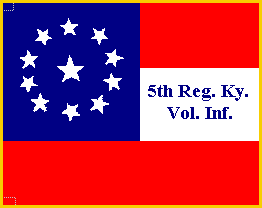 |
| A Bath County farmer, Hawkins helped organize the 5th Kentucky in the Fall of 1861. He won his spurs at Ivy Mountain, and at Princeton, West Virginia, he led the charge which resulted in the Confederate victory. In the Spring of 1863 he assumed command of the 5th Kentucky, and during the Battle of Chickamauga he and his men captured two Union regiments. Born near Owingsville, Kentucky in 1826, Hiram Hawkins engaged in farming until 1860, when he was elected to the state legislature on the Democratic ticket. He was fond of the military life, and in 1855 he was elected Colonel of the Bath County Militia. Hawkins initially opposed secession, but he abhorred the coercionist tactics of the Republicans, and by the Summer of 1861 he was urging his fellow Kentuckians to join the Confederacy. In September, 1861, fleeing arrest, he called together his Bath County militia and took them to Prestonsburg, where they were mustered into the 5th Kentucky Infantry, C.S.A. Being the oldest and most experienced militia officer at the camp, Hawkins was chosen camp commander. Hawkins was one of the ranking Confederate officers at the Battle of Ivy Mountain (November 8th, 1861), along with Jack May, Ezekiel Clay, and James M. Thomas. All four were cited for gallantry by Confederate Secretary of War Judah P. Benjamin. Later that year, when the 5th Kentucky joined Marshall’s brigade at Pound Gap, Hawkins was promoted to major and given command of half of the regiment. Hawkins and his men served with Marshall during the Spring and Fall of 1862, and during the Battle of Princeton (May 16th, 1862) he led the 5th Kentucky in the assault which resulted in the Confederate victory. During the period of demoralization which followed the Confederate defeat at Perryville on October 8th, 1862, Hawkins canvassed Eastern Kentucky for recruits, collecting enough to replace the men who had left the regiment after their term of service had expired. In the Spring of 1863 Hawkins was promoted to Colonel and placed in command of the regiment. Transferred to General Bragg’s command, the 5th Kentucky saw action at Chickamauga, Missionary Ridge, Resaca, Dalton, Jonesboro, and other important battles. At Chickamauga they played an important role in the Confederate victory. On September 20th, 1863, the second day of the battle, Hawkins led his men in a charge which resulted in the capture of two Union regiments. After the Battle of Jonesboro the regiment was converted to mounted infantry and attached to Wheeler’s Cavalry Corps. During Sherman’s march through Georgia, Hawkins and his men helped Georgia’s plantation owners protect their livestock and womenfolk from Sherman’s “bummers.” The regiment surrendered at Washington, Georgia on May 6th, 1865. Finding southern life congenial, Hawkins settled in Alabama at the war’s conclusion, purchasing a farm in Barbour County and marrying the widow of one of his fallen comrades. In the 1870s he was elected to the Alabama State Legislature, where he spearheaded the effort to establish the Alabama Department of Agriculture. He died in 1914 and is buried in the Fairview Cemetery in Eufaula, Alabama. |
| Colonel Hiram Hawkins of the 5th Kentucky |
 |
 |
| Colonel George W. Monroe Colonel Ezekiel F. Clay Colonel Lionel A. Sheldon Colonel Don A. Pardee Colonel John S. Williams Colonel Alfred C. Moore Colonel George W. Gallup Dr. Stephen M. Ferguson |
| Photo courtesy of Howard Swarts of Owingsville, Kentucky |